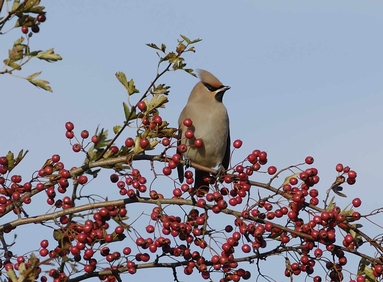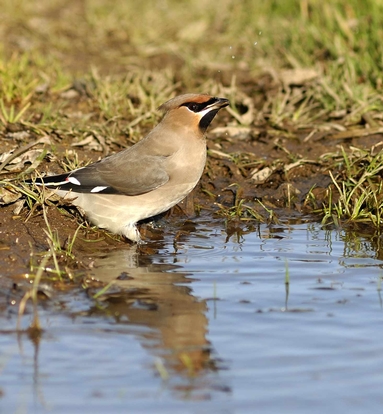Waxwing


In October 2010 there was the biggest arrival in years of Waxwing in the UK.
Birds flooded in on Sunday 24 and Monday 25 October. On those two days alone, over 2,700 birds were reported in Scotland, with many smaller flocks along the English east coast. The biggest flocks were reported on Tuesday 26 October, with 480 in Pitlochry and 320 in Aberfeldy according to www.birdguides.com.
Arran did not miss out in this “invasion”.
At lunch time on Thursday 21 October five Waxwings were reported at Invercloy in Brodick. This was the first report. Later that day there were fifteen by Brodick Bowling Grreen. On Saturday 23 Ocober in the afternoon there was up to thirty Waxwings in the trees of the Royal Hotel Whiting Bay and the adjacent Whiting Bay Primary School. The birds were still around this area on Sunday afternoon. Also on Sunday afternoon there was a flock of around ten birds in the trees close to Brodick Library, six around the Catacol Bay Hotel and fifty in Kingscross. In some cases, observers were getting within five metres of these very confiding birds.
On Monday 25 October reports included; forty in Brodick, twenty over High Kildonan flying west, thirteen by the lay by with the phone box in Sannox, one in a bus shelter in Sandbraes, thirty by the golf course in Lochranza, and twenty sitting on a TV aerial in Pirnmill. Widespread reports continued throughout the week with up to one hundred by the Auchrannie on Saturday 30 October.
Last winter on Arran there were only three records and none before January. The previous winter 2008/2009 was a good winter for Waxwing on Arran with the first report on 12 November 2008 and up to one hundred birds being seen later in the month.
These Nordic nomads are an 'irruptive' species, only arriving in numbers in certain winters, dictated to a large extent by conditions in their native Scandanavia.
Waxwings can be very confiding, allowing a great view of their large crest, pinkish brown body and eponymous waxy wings. Brian Couper’s photographs capture these stunning birds beautifully. The waxy tips are actually the extended shafts of the feathers, and the number seen will identify the age and sex of the bird, ranging from none on young females to eight on adult males. Listen out for their distinctive trilling call too, sounding oddly reminiscent of "sid-little".
Be prepared for them turning up anywhere where there are trees and bushes with bright red and orange berries even those on ornamental trees.